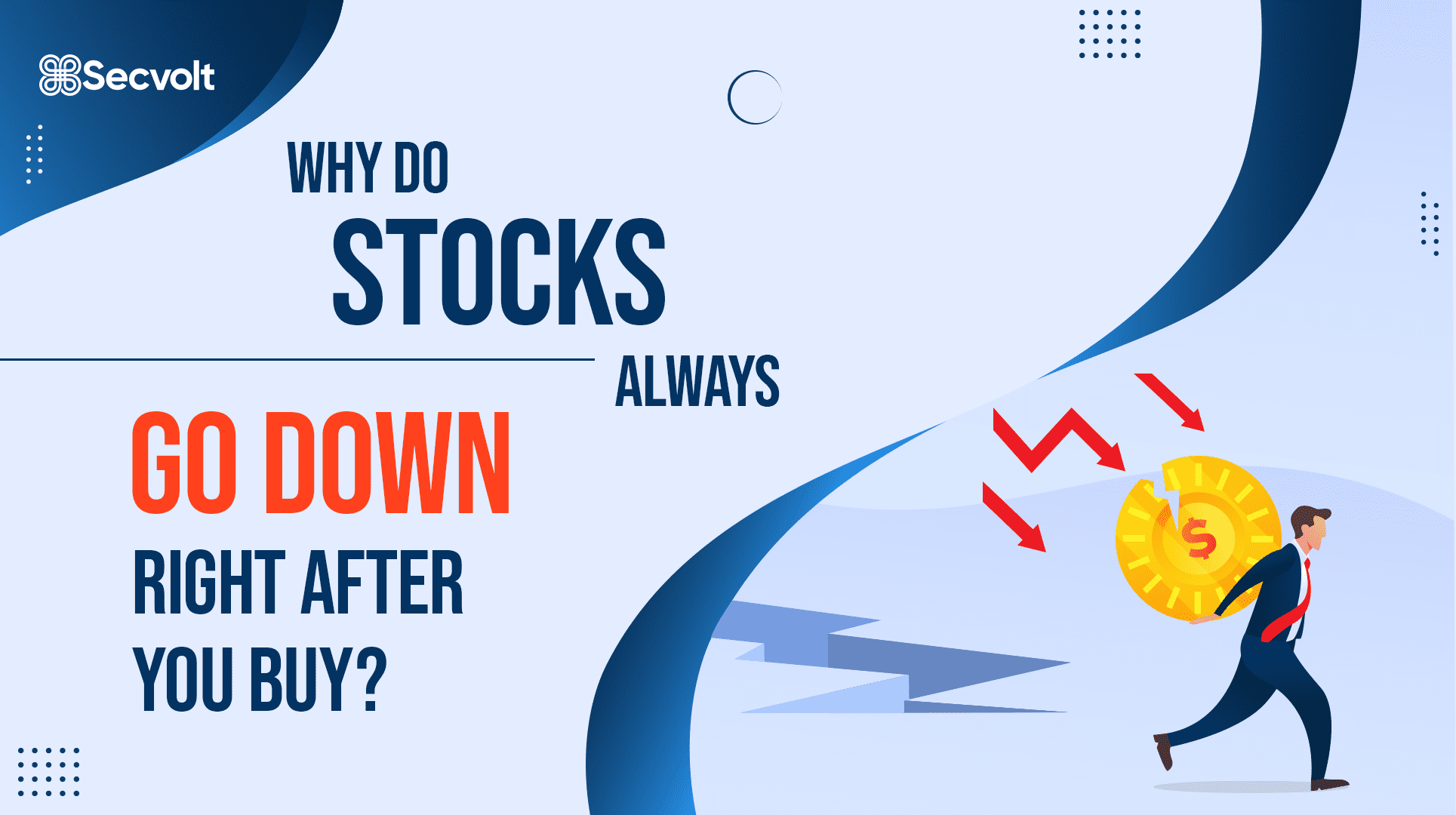While investing in the stock market comes with inherent risk, there are steps investors can take to reduce the impact of stock drops, such as diversifying their portfolios and taking a long-term investment perspective. Avoiding stock drops after buying is a combination of technical and psychological factors. Diversification, long-term investment perspective, thorough research, investment psychology management, and avoid timing the market are some of the key factors that can help reduce the risk of stock drops.
Stocks are one of the most popular investments, but it can be frustrating when they drop right after you buy. This is a common phenomenon that occurs when investors go through the classic investment adage “buy low, sell high.” The drop in prices can be due to various technical and psychological factors. In this blog, we will explore the reasons behind these drops, the risks associated with them, and how you can avoid them. From understanding market trends to timing the market, we will provide insights and strategies to help you navigate this tricky terrain and minimize your losses.
So, let us start by understanding why stocks go down right after you buy.
Why Do Stocks Always Go Down Right After You Buy?
Stocks can drop after you buy for various technical, market-related, and non-technical, psychological reasons. Let us first have a look at the technical, market-related reasons for the same:
Technical Factors:
Market Volatility – Market volatility is one of the most common reasons why stocks drop after purchase. This refers to the rapid changes in the value of a stock and happens due to different factors such as global events, economic data releases, or changes in the stock’s underlying fundamentals. This volatility can result in sudden and sharp declines in stock prices, even right after you’ve made your purchase.
Timing Risk – Timing the market is a challenge for even the most seasoned investors. Stocks may decline after you buy because you have purchased at a high point, just before a drop. This is a risk that is inherent in any investment and highlights the importance of timing and careful market analysis.
Market Correction – Market corrections refer to a drop of 10% or more in the value of a stock market index and can result in a decline in individual stock prices as well. These corrections are a normal part of the market cycle and occur as a result of investor sentiment and the reevaluation of a stock’s underlying value.
Economic Indicators – Economic indicators such as interest rates, inflation, and unemployment rates can have a significant impact on stock prices. Sudden changes in these indicators can result in drops in the stock market and therefore a decline in the value of individual stocks.
Company-Specific Factors- Finally, stock drops can also be a result of company-specific factors such as poor earnings reports, management changes, or regulatory issues. These factors can result in a decline in a stock’s value, even if the overall market is performing well.
These are the technical factors. Next, let us discuss the non-technical, psychological factors responsible for the fall in stock prices right after buying them.
If you need some ideas about what to read next, here they are:
Psychological Factors Responsible For The Fall In Stock Prices
An investor’s mindset, behavior, and psychology also play a vital role in determining the fall, rise, and different variations in a stock’s prices. Let us now have a look at the non-technical factors affecting the prices:
Buy Low, Sell High- One of the most fundamental rules of investing is to buy low and sell high. Unfortunately, this is easier said than done, and many investors struggle with this concept. The natural inclination to want to buy stocks when they are at their highest often leads to purchases right before a decline in stock prices.
Emotion-Driven Decisions– Emotional investing can often lead to poor investment decisions. Fear and greed are two of the most common emotions that drive investors to make impulsive decisions, leading to purchases at the wrong time and resulting in drops in stock prices.
Overconfidence Bias– Overconfidence bias refers to the belief that we are better at making investment decisions than we actually are. This can lead to impulsive purchases and a lack of consideration for market conditions and trends, resulting in declines in stock prices after purchase.
Herding Behavior– Herding behavior refers to the tendency of individuals to follow the crowd and make investment decisions based on the actions of others. This can result in a surge in demand for certain stocks, driving up prices, and leading to a drop in prices after the initial surge subsides.
Behavioral Finance Theory- Behavioral finance theory highlights the role that psychology and behavior play in investment decisions. This theory suggests that the irrational behavior of investors can result in suboptimal investment outcomes, including declines in stock prices after purchase.
So, we have seen the technical & non-technical factors responsible for the decline in stock prices right after buying them. Next, let us discuss the impacts of this phenomenon on investors.
Impacts on Investors of Stocks Going Down Right After You Buy
Following are the various impacts that investors face when stocks go down immediately after buying:
Loss of Capital – One of the most immediate impacts of stocks going down right after you buy is the loss of the capital invested. This can be especially damaging if a large portion of the portfolio is in a stock that has declined in value.
Reduced Confidence in Investing – A decline in the value of stock soon after purchase can reduce an investor’s confidence in their investment abilities and their willingness to invest in the future. It’s important to maintain a long-term perspective and understand that market fluctuations are a normal part of investing.
Missed Opportunities – Selling a declining stock can result in missing out on potential future gains if the stock price were to rebound. It’s important to maintain a long-term investment strategy and avoid making knee-jerk reactions based on short-term market fluctuations.
Increased Anxiety – Watching the value of a stock decline soon after purchase can result in increased anxiety and stress for investors. It’s important to understand the risks associated with investing and maintain a level-headed approach, avoiding short-term reactions to market fluctuations.
Reduced Portfolio Diversity – Selling a declining stock to minimize losses can result in reducing the diversity of an investment portfolio. This can increase the risk of a negative impact on a portfolio by market corrections in a specific sector. It’s important to maintain a well-diversified portfolio to reduce the impact of market fluctuations on the overall portfolio.
These are the effects investors face of the fall in stock prices immediately after buying. Now, you must be wondering how to avoid this decline in stock prices. Thus, let us discuss the same next.
How Can You Avoid Stock Drops After Buying?
We have seen why stocks always go down right after you buy them and the impact of the same on the investors. Following are some points on how you can avoid the stock drops after buying:
Diversification– Diversifying your investment portfolio can help reduce the impact of market fluctuations in specific sectors. Consider investing in a mix of stocks, bonds, and other assets to spread your risk. By diversifying, you reduce the risk of buying high and selling low in a single stock or sector.
Long-Term Investment Perspective- Adopting a long-term investment perspective can help reduce the impact of short-term market fluctuations. This approach can also help reduce the effect of psychological factors such as fear and greed on investment decisions. A long-term perspective is essential in successfully executing the buy low, sell high strategy.
Investment Research- Thorough research and due diligence before investing can help reduce the risk of stock drops after buying. Consider factors such as company financials, industry trends, and market conditions before making an investment. The more you know about a stock before you buy, the better positioned you are to execute the buy low, sell high strategy.
Investment Psychology Management- Managing investment psychology and avoiding knee-jerk reactions to market fluctuations can help reduce the impact of stock drops after buying. Consider seeking professional help from a financial advisor to help manage investment psychology. By avoiding emotional decision-making, you can increase your chances of executing the buy low, sell high strategy successfully.
Timing the Market- Avoid trying to time the market by buying and selling stocks based on short-term market fluctuations. This approach is often unsuccessful and can result in missed opportunities for investment gains. Instead, focus on a long-term investment strategy and buying stocks at fair prices with the potential for long-term growth. Timing the market goes against the traditional buying low & selling high approach.
By taking these steps, investors can reduce the risk of stock drops and maximize the potential for investment success while adhering to the buy low, sell high strategy. In the final section, let us also look at a hedge fund that has managed to break all the records with its YTD results in 2022, despite the economic fluctuations.
The Bottom Line
Join Our Newsletter
Elevate your financial game & join the ranks of elite investors with Secvolt’s exclusive newsletter.
Join Our Newsletter
Elevate your financial game & join the ranks of elite investors with Secvolt’s exclusive newsletter.
Don’t just dream of wealth; achieve it with Secvolt. Schedule a call today for personalized guidance on your investment strategy and join the ultra-successful.
Ready to unlock your wealth’s truest potential & cherish affluence?
Secvolt, our hedge fund, sets the bar high with a record-breaking performance of 262% returns in 2022. With the brilliance of our highly advanced quant models and the efficiency of our risk mitigation protocols, we are yet to see a loss!
We’re the perfect ally to help you succeed financially and build the lasting legacy you have always aspired for.
Get in touch today. YOUR LEGACY AWAITS YOU…






